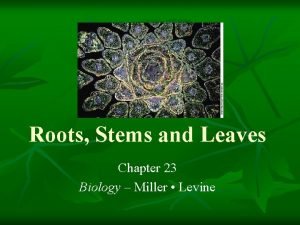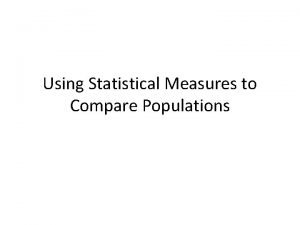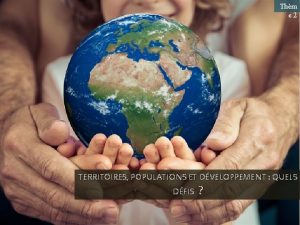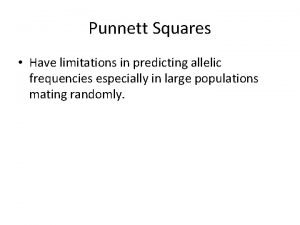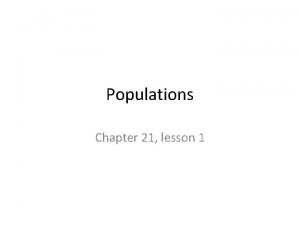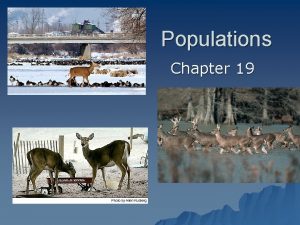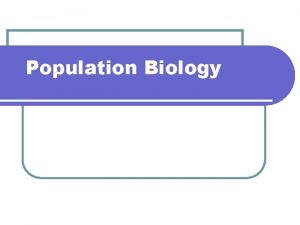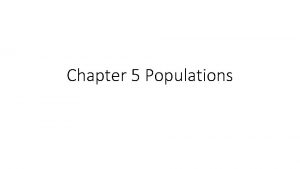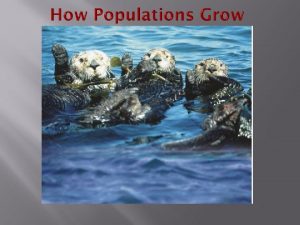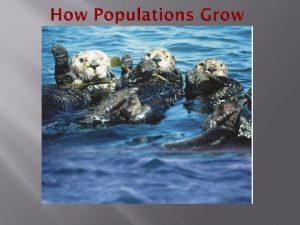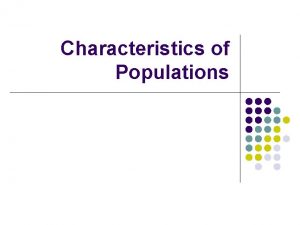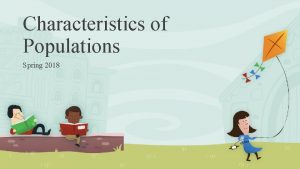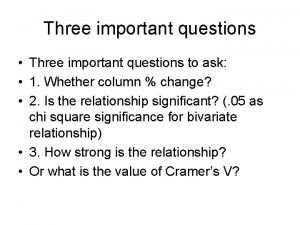Characteristics of Populations Three important characteristics of a















- Slides: 15


Characteristics of Populations Three important characteristics of a population are its: a. geographic distribution b. population density c. growth rate http: //www. youtube. com/watch? v=RBOsqm. BQBQk

Population Growth Three factors can affect population size: a. the number of births b. the number of deaths c. the number of individuals that enter or leave the population A population can grow when its birthrate is greater than its death rate.

Immigration, the movement of individuals into an area Emigration, the movement of individuals out of an area

Under perfect conditions with unlimited resources, a population will grow exponentially. Exponential Growth Copyright Pearson Prentice Hall

As resources become less available (no more space, food, water, etc. ), the growth of a population slows or stops. Called carrying capacity Copyright Pearson Prentice Hall

Are humans experiencing exponential or logistic growth? Do you think humans are close to the Earth’s carrying capacity? Why? Copyright Pearson Prentice Hall

In the context of populations, a limiting factor is a factor that causes population growth to decrease. Can be: Density-dependent Density-independent

Density-Dependent Factors a. A limiting factor that depends on population size is called a density-dependent limiting factor. Density-dependent limiting factors include: a. competition b. predation c. parasitism d. Disease e. Most impact with larger populations

Competition a. When populations become crowded, organisms compete for food, water space, sunlight and other essentials.

Competition can also occur: between members of same species (intraspecific) between members of different species (interspecific) Intraspecific Interspecific

Predation a. Populations in nature are often controlled by predation. Or Predator – Prey Relationship Copyright Pearson Prentice Hall

Wolf and Moose Populations on Isle Royale Copyright Pearson Prentice Hall

Parasitism and Disease a. Parasites can limit the growth of a population. b. http: //www. ted. com/talks/ed_yong_suicidal_wasps_zomb ie_roaches_and_other_tales_of_parasites

Density-Independent Factors a. Density-independent limiting factors affect all populations in similar ways, regardless of the population size. • • unusual weather natural disasters seasonal cycles certain human activities—such as damming rivers and clear-cutting forests
 From most important to least important in writing
From most important to least important in writing From most important to least important in writing
From most important to least important in writing Least important to most important
Least important to most important Name three important values of shang culture
Name three important values of shang culture What are the functions of stems
What are the functions of stems Using statistical measures to compare populations
Using statistical measures to compare populations Territoires populations et développement quels défis
Territoires populations et développement quels défis Stabilizing selection human birth weight
Stabilizing selection human birth weight A biologist discovers two populations of wolf spiders
A biologist discovers two populations of wolf spiders Limitations of using a punnett square
Limitations of using a punnett square Lesson 1 populations answer key
Lesson 1 populations answer key Section 19-2 review measuring populations
Section 19-2 review measuring populations Chapter 16 evolution of populations vocabulary review
Chapter 16 evolution of populations vocabulary review Gene pool
Gene pool Population biology definition
Population biology definition Whats a density dependent limiting factor
Whats a density dependent limiting factor




